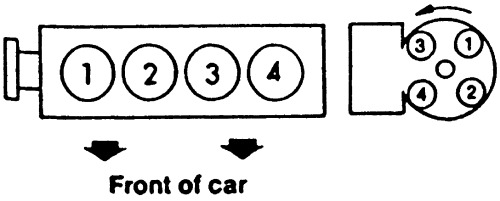The Toyota 4A-GE engine has earned a legendary reputation among car enthusiasts for its reliability, high-revving nature, and tunability. Whether you’re maintaining, troubleshooting, or modifying this iconic engine, understanding the firing order is essential.
This guide dives deep into the 4A-GE firing order, breaking it down into manageable parts while keeping the tone conversational and practical.

Quick Navigation
What is the Firing Order of Toyota 4A-GE Engine?
In the case of the 4A-GE engine, the firing order is 1-3-4-2, a sequence that’s common among inline-four engines.

The firing order is the sequence in which the engine’s cylinders ignite their air-fuel mixture. This ignition process generates the power that drives the pistons, rotates the crankshaft, and ultimately powers the vehicle.
Why is the Firing Order Important?
The firing order is critical for:
- Smooth Operation: It ensures power is distributed evenly across the engine’s cylinders.
- Minimized Vibrations: A balanced firing sequence prevents unnecessary vibrations that could harm the engine.
- Optimal Performance: It maximizes combustion efficiency, contributing to better power and fuel economy.
How the 4A-GE Firing Order Works
The 1-3-4-2 firing order determines the order in which the cylinders fire. Here’s a breakdown of how it works:
- Cylinder 1 Fires First: The ignition process begins with cylinder 1, initiating the power stroke.
- Cylinder 3 Fires Next: Cylinder 3 follows, contributing the next burst of energy.
- Cylinder 4 Fires Third: Cylinder 4 continues the sequence, keeping the engine’s rotation balanced.
- Cylinder 2 Fires Last: Finally, cylinder 2 completes the cycle before the pattern repeats.
This sequence ensures a steady and balanced power delivery, preventing engine imbalances and optimizing performance.
Understanding the 4A-GE Engine Layout
The 4A-GE engine is an inline-four engine, which means all four cylinders are aligned in a straight row. To understand the firing order, you must first identify the cylinder layout.
Cylinder Numbering:
- Cylinder 1: Closest to the timing belt or accessory drive (front of the engine).
- Cylinder 4: Farthest from the timing belt, near the transmission.
This consistent numbering makes it easy to locate and work on individual cylinders.
Key Components That Affect the Firing Order
Several components work together to execute the firing order in the 4A-GE engine. Each one plays a vital role in ensuring the cylinders fire in the correct sequence:
- Crankshaft: Converts the pistons’ linear motion into rotational energy, coordinating with the firing order.
- Camshafts: Control the opening and closing of the intake and exhaust valves, ensuring precise timing for combustion.
- Distributor or ECU: Directs electrical current to the spark plugs in the correct order.
- Spark Plugs: Ignite the air-fuel mixture in each cylinder.
- Ignition Coils: Provide the necessary voltage for spark generation (in distributor-less systems).
Each of these components must function correctly for the firing order to work as intended.
Symptoms of a Faulty Firing Order
If the firing order is disrupted, the 4A-GE engine will exhibit noticeable symptoms. Recognizing these issues early can prevent serious damage:
Misfires
When a cylinder fires out of sequence, it disrupts the engine’s rhythm, leading to misfires.
Rough Idling
An incorrect firing order can cause the engine to run unevenly, resulting in vibrations or stalling during idle.
Loss of Power
The engine may struggle to produce power, affecting acceleration and overall performance.
Knocking or Backfiring
Premature combustion due to incorrect timing may cause knocking sounds or backfires.
Increased Fuel Consumption
An engine working harder to compensate for firing order issues will burn more fuel, reducing efficiency.
How to Verify and Correct the Firing Order
If you suspect firing order issues in your 4A-GE engine, follow these steps to diagnose and correct them:
Step 1: Inspect Spark Plug Wires
- Ensure each wire connects the distributor (or ignition coil) to the correct cylinder in the 1-3-4-2 sequence.
- Look for cracks, corrosion, or loose connections in the wires.
Step 2: Check the Distributor Cap
- Verify that the distributor cap is properly aligned with the rotor. Misalignment can disrupt the firing sequence.
- Replace the cap if it shows signs of wear or damage.
Step 3: Use a Timing Light
- Attach a timing light to cylinder 1 and observe the timing marks on the crankshaft pulley.
- Adjust the timing if necessary to match manufacturer specifications.
Step 4: Consult the Engine Manual
- Refer to the 4A-GE service manual for diagrams and specific instructions on the firing order and ignition system.
Step 5: Test the Engine
- After adjustments, start the engine and monitor its operation. If problems persist, recheck the ignition components and wiring.
Maintenance Tips for Preserving the Firing Order
Proper maintenance is essential to keep the 4A-GE engine running smoothly and prevent firing order issues. Here are some tips:
Replace Spark Plugs Regularly
- Worn or fouled spark plugs can disrupt ignition. Replace them at the intervals recommended by Toyota.
Inspect Ignition Wires
- Check for damage or wear in the wires. Replace any that show signs of cracking or corrosion.
Service the Distributor or ECU
- Clean and inspect the distributor if your 4A-GE uses one. For electronic ignition systems, monitor the ECU for error codes.
Verify Engine Timing
- Periodically check and adjust the engine timing using a timing light to ensure it aligns with the firing order.
Keep the Fuel System Clean
- Ensure the fuel injectors and fuel lines are free of debris to support efficient combustion.
Common Misconceptions About the Firing Order
Let’s clear up a few common myths about firing orders:
“All Inline-Four Engines Use the Same Firing Order”
While 1-3-4-2 is standard, some engines use different sequences based on their design.
“The Firing Order Can Be Adjusted for Performance”
Altering the firing order without redesigning the engine can cause severe damage.
“Firing Order Doesn’t Affect Longevity”
An incorrect firing order increases wear and tear on components, shortening the engine’s lifespan.
Why Understanding the Firing Order Matters
Knowing the firing order of your 4A-GE engine empowers you to:
- Perform basic maintenance confidently.
- Diagnose engine problems more effectively.
- Communicate clearly with mechanics or fellow enthusiasts.
This understanding not only saves time and money but also helps you get the most out of your engine.
Engines with Similar Firing Orders
- Mark X Firing Order
- 2007 Toyota Camry Firing Order
- 2009 Toyota Camry Firing Order
- 2004 Toyota Camry Firing Order
Conclusion
The firing order of the 4A-GE engine, 1-3-4-2, is a critical aspect of its operation. By maintaining this sequence and ensuring all related components are in good condition, you can enjoy smooth engine performance, better fuel efficiency, and a longer lifespan for your engine. Whether you’re tuning your 4A-GE for the track or preserving it as a daily driver, understanding the firing order is a fundamental part of keeping this iconic engine running at its best.
With proper maintenance and attention to detail, your 4A-GE will continue to deliver the thrilling performance it’s famous for, mile after mile.

